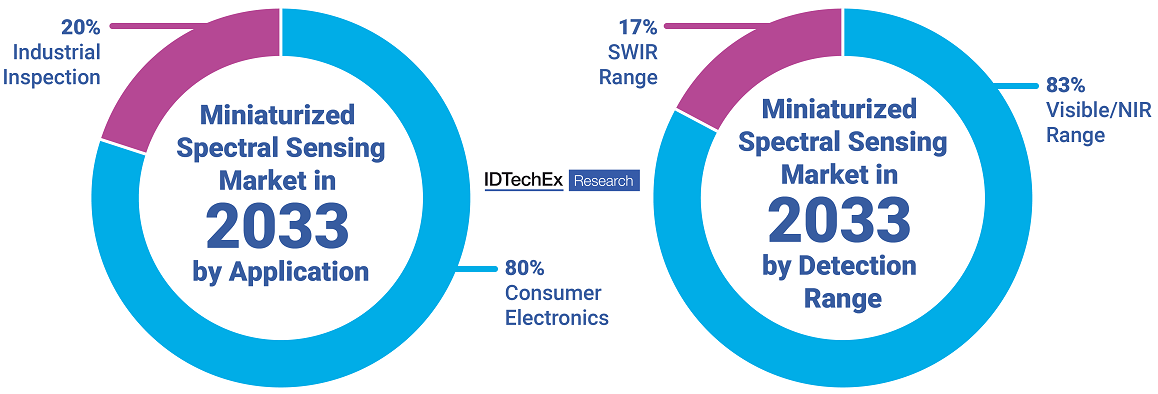Unsatisfied with smartphone camera color reproduction? Would it be useful for a user to detect different materials or even assess the freshness of food using a phone or other household appliance? The emerging technology of miniaturized spectrometers and multispectral cameras holds the solution. By detecting spectral information rather than just simple RGB color coordinates, these affordable devices can reveal previously available information via specialist equipment.
 Miniaturized spectral sensing market in 2033 – by application and detection range. Source: IDTechEx
Miniaturized spectral sensing market in 2033 – by application and detection range. Source: IDTechEx
Acquiring spectral information with affordable sensors is part of a growing trend to detect optical information beyond what the eye can detect. As machine vision capabilities improve, algorithms demand more comprehensive input data than conventional RGB sensors can provide.
IDTechEx’s report, “Emerging Image Sensor Technologies 2023-2033: Applications and Markets”, covers a wide range of these emerging image sensor types, including shortwave infrared (SWIR) sensors based on organic semiconductors, quantum dots or germanium, event-based vision, hyperspectral imaging, quantum imaging and more.
Application Opportunities
The desire to add more functionality in pursuit of differentiation means that spectral image sensors are in demand for smartphones. In 2021, German research center Fraunhofer ENAS announced its objective to produce infrared spectrometers for smartphone integration that weigh 1 gram and cost just US$1. This is a substantial improvement on the classic infrared spectrometers that weigh several kilograms and cost thousands of dollars. Fraunhofer’s low-cost spectrometer will be able to detect fake medicine and drugs, test air quality, and analyze food decomposition.
A notable player commercializing affordable spectral sensing is Spectricity, an early-stage Belgian company. Earlier this year, it announced its first product – a miniaturized multispectral image sensor that can detect 16 color channels within the visible region. The greater spectral resolution compared to conventional sensors enables more accurate color reproduction, with smartphones the target market given that camera quality is determining factor for many consumer purchase decisions.
Another consumer application that can benefit from spectral sensing is wearable health monitoring. While smartwatches can already track heart rate, oxygen levels, sleep patterns and respiration rates using LED light sensors, but more sophisticated sensors would provide greater functionality. Spectrally resolving wavelengths beyond 1000 nm, for example, by using one of the emerging SWIR (short wave infrared) detection technologies such as quantum dots, enables the detection of biomarkers undetectable by visible and NIR light. Wearable devices could then monitor glucose, lactate, hydration, and alcohol levels, broadening their appeal and providing a source of differentiation amongst the current field of smartwatches with increasingly similar capabilities.
Along with consumer electronics, miniaturized spectrometers and multispectral cameras are expected to gain traction for industrial inspection and robotics since lightweight permits integration into existing equipment. The most promising tasks are object recognition and distinguishing between different materials. Spectral resolution is especially valuable when aiming to distinguish visually similar materials such as different plastics or oil/water.
Outlook
Due to their compact nature and affordability, miniaturized spectrometers and multispectral sensors promise to bring new capabilities to handheld devices, portable electronics, and industrial imaging inspection equipment. Capabilities that were once the preserve of the laboratory can now be applied to smartwatches, smartphones, and even robotic vacuums.
IDTechEx’s report “Emerging Image Sensor Technologies 2023-2033: Applications and Markets” explores a diverse range of image sensing technologies capable of resolutions and wavelength detection far beyond what is currently attainable. Many of these emerging technologies are expected to make waves within numerous sectors, including robotics, industrial imaging, healthcare, biometrics, autonomous driving, agriculture, chemical sensing, and food inspection. IDTechEx expects that the growing importance of autonomous technologies will lead the emerging image sensor market to over US$500 million by 2033.